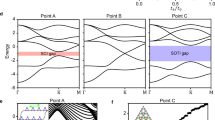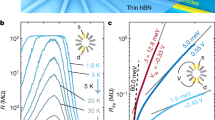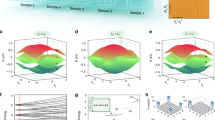Abstract
Quantum simulators are essential tools for understanding complex quantum materials. Platforms based on ultracold atoms in optical lattices and photonic devices have led the field so far, but the basis for electronic quantum simulators is now being developed. Here, we experimentally realize an electronic higher-order topological insulator (HOTI). We create a breathing kagome lattice by manipulating carbon monoxide molecules on a Cu(111) surface using a scanning tunnelling microscope. We engineer alternating weak and strong bonds to show that a topological state emerges at the corner of the non-trivial configuration, but is absent in the trivial one. Different from conventional topological insulators, the topological state has two dimensions less than the bulk, denoting a HOTI. The corner mode is protected by a generalized chiral symmetry, which leads to a particular robustness against perturbations. Our versatile approach to designing artificial lattices holds promise for revealing unexpected quantum phases of matter.
This is a preview of subscription content, access via your institution
Access options
Access Nature and 54 other Nature Portfolio journals
Get Nature+, our best-value online-access subscription
$29.99 / 30 days
cancel any time
Subscribe to this journal
Receive 12 print issues and online access
$259.00 per year
only $21.58 per issue
Buy this article
- Purchase on Springer Link
- Instant access to full article PDF
Prices may be subject to local taxes which are calculated during checkout




Similar content being viewed by others
Data availability
All data are available from the corresponding authors on reasonable request. The experimental data can be accessed using open-source tools.
References
Feynman, R. P. There’s plenty of room at the bottom. Eng. Sci. 23, 22–36 (1960).
Georgescu, I. M., Ashhab, S. & Nori, F. Quantum simulation. Rev. Mod. Phys. 86, 153–185 (2014).
Greiner, M., Mandel, O., Esslinger, T., Hänsch, T. W. & Bloch, I. Quantum phase transition from a superfluid to a Mott insulator in a gas of ultracold atoms. Nature 415, 39–44 (2002).
Bloch, I., Dalibard, J. & Nascimbene, S. Quantum simulations with ultracold quantum gases. Nat. Phys. 8, 267–276 (2012).
Blatt, R. & Roos, C. F. Quantum simulations with trapped ions. Nat. Phys. 8, 277–284 (2012).
Aspuru-Guzik, A. & Walther, P. Photonic quantum simulators. Nat. Phys. 8, 285–291 (2012).
Gomes, K. K., Mar, W., Ko, W., Guinea, F. & Manoharan, H. C. Designer Dirac fermions and topological phases in molecular graphene. Nature 483, 306–310 (2012).
Crommie, M. F., Lutz, C. P. & Eigler, D. M. Confinement of electrons to quantum corrals on a metal surface. Science 262, 218–220 (1993).
Hirjibehedin, C. F., Lutz, C. P. & Heinrich, A. J. Spin coupling in engineered atomic structures. Science 312, 1021–1024 (2006).
Khajetoorians, A. A., Wiebe, J., Chilian, B. & Wiesendanger, R. Realizing all-spin–based logic operations atom by atom. Science 332, 1062–1064 (2011).
Slot, M. R. et al. Experimental realization and characterization of an electronic Lieb lattice. Nat. Phys. 13, 672–676 (2017).
Drost, R., Ojanen, T., Harju, A. & Liljeroth, P. Topological states in engineered atomic lattices. Nat. Phys. 13, 668–671 (2017).
Slot, M. R. et al. p-band engineering in artificial electronic lattices. Phys. Rev. X 9, 011009 (2019).
Collins, L. C., Witte, T. G., Silverman, R., Green, D. B. & Gomes, K. K. Imaging quasiperiodic electronic states in a synthetic penrose tiling. Nat. Commun. 8, 15961 (2017).
Kempkes, S. N. et al. Design and characterization of electrons in a fractal geometry. Nat. Phys. 15, 127–131 (2019).
Moore, J. E. The birth of topological insulators. Nature 464, 194–198 (2010).
Haldane, F. D. M. Nobel lecture: topological quantum matter. Rev. Mod. Phys. 89, 040502 (2017).
Hasan, M. Z. & Kane, C. L. Topological insulators. Rev. Mod. Phys. 82, 3045–3067 (2010).
Benalcazar, W. A., Bernevig, B. A. & Hughes, T. L. Quantized electric multipole insulators. Science 357, 61–66 (2017).
Noh, J. et al. Topological protection of photonic mid-gap defect modes. Nat. Photon. 12, 408–415 (2018).
Schindler, F. et al. Higher-order topology in bismuth. Nat. Phys. 14, 918–924 (2018).
Mittal, S. et al. Photonic quadrupole topological phases. Nat. Photon. https://doi.org/10.1038/s41566-019-0452-0 (2019).
El Hassan, A. et al. Corner states of light in photonic waveguides. Preprint at https://arxiv.org/abs/1812.08185 (2018).
Serra-Garcia, M. et al. Observation of a phononic quadrupole topological insulator. Nature 555, 342–345 (2018).
Imhof, S. et al. Topolectrical-circuit realization of topological corner modes. Nat. Phys. 14, 925–929 (2018).
Peterson, C. W., Benalcazar, W. A., Hughes, T. L. & Bahl, G. A quantized microwave quadrupole insulator with topologically protected corner states. Nature 555, 346–350 (2018).
Xue, H., Yang, Y., Gao, F., Chong, Y. & Zhang, B. Acoustic higher-order topological insulator on a kagome lattice. Nat. Mater. 18, 108–112 (2019).
Ni, X., Weiner, M., Alú, A. & Khanikaev, A. B. Observation of higher-order topological acoustic states protected by generalized chiral symmetry. Nat. Mater. 18, 113–120 (2019).
Ezawa, M. Higher-order topological insulators and semimetals on the breathing kagome and pyrochlore lattices. Phys. Rev. Lett. 120, 026801 (2018).
Benalcazar, W. A., Li, T. & Hughes, T. L. Quantization of fractional corner charge in C n-symmetric higher-order topological crystalline insulators. Phys. Rev. B 99, 245151 (2019).
Bartels, L., Meyer, G. & Rieder, K.-H. Basic steps of lateral manipulation of single atoms and diatomic clusters with a scanning tunneling microscope tip. Phys. Rev. Lett. 79, 697–700 (1997).
Meyer, G. et al. Controlled manipulation of atoms and small molecules with a low temperature scanning tunneling microscope. Single Mol. 1, 79–86 (2000).
Celotta, R. J. et al. Invited article: autonomous assembly of atomically perfect nanostructures using a scanning tunneling microscope. Rev. Sci. Instrum. 85, 121301 (2014).
Acknowledgements
We acknowledge H. Hansson, D. Haldane and M. Franz for fruitful discussions. W.A.B. thanks the Eberly Postdoctoral Fellowship at The Pennsylvania State University for support. The work of D.B. is supported by Spanish Ministerio de Ciencia, Innovation y Universidades (MICINN) under project FIS2017-82804-P and by the Transnational Common Laboratory Quantum–ChemPhys. D.V., I.S. and C.M.S. acknowledge funding from the Nederlandse Organisatie voor Wetenschappelijk Onderzoek via grants 16PR3245 and DDC13, and D.V. acknowledges the European Research Council Advanced Grant FIRSTSTEP 692691.
Author information
Authors and Affiliations
Contributions
S.N.K. and J.J.v.d.B. performed the theoretical calculations under the supervision of C.M.S., W.A.B. and D.B. M.R.S., S.N.K. and I.S. planned the experiment. M.R.S. performed the experiment and data analysis with contributions from P.C. under the supervision of I.S. and D.V. C.M.S., S.N.K. and M.R.S. wrote the manuscript with input from all authors.
Corresponding authors
Ethics declarations
Competing interests
The authors declare no competing interests.
Additional information
Publisher’s note Springer Nature remains neutral with regard to jurisdictional claims in published maps and institutional affiliations.
Supplementary information
Supplementary Information
Supplementary Figs. 1–15, Notes 1–4 and refs. 1–13.
Rights and permissions
About this article
Cite this article
Kempkes, S.N., Slot, M.R., van den Broeke, J.J. et al. Robust zero-energy modes in an electronic higher-order topological insulator. Nat. Mater. 18, 1292–1297 (2019). https://doi.org/10.1038/s41563-019-0483-4
Received:
Accepted:
Published:
Issue Date:
DOI: https://doi.org/10.1038/s41563-019-0483-4
This article is cited by
-
Isolated flat band in artificially designed Lieb lattice based on macrocycle supramolecular crystal
Communications Materials (2024)
-
Artificial kagome lattices of Shockley surface states patterned by halogen hydrogen-bonded organic frameworks
Nature Communications (2024)
-
One-dimensional topological phase and tunable soliton states in atomic nanolines on Si(001) surface
npj Quantum Materials (2024)
-
Realization of photonic p-orbital higher-order topological insulators
eLight (2023)
-
A solid-state quantum microscope for wavefunction control of an atom-based quantum dot device in silicon
Nature Electronics (2023)



